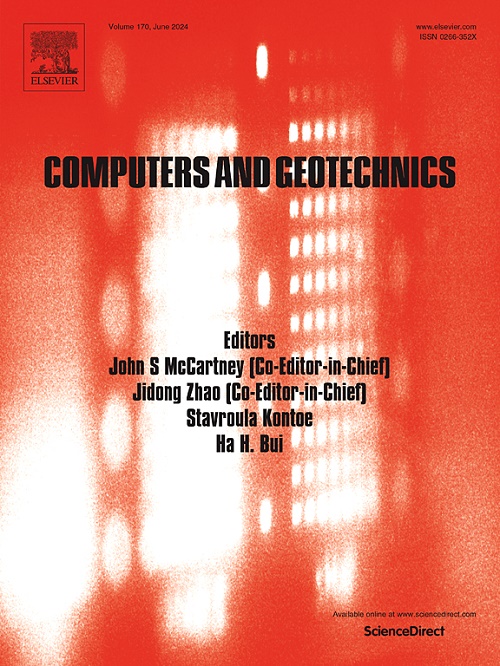考虑水-土耦合效应的沉管隧道随机地震反应及抗震可靠度评价
IF 6.2
1区 工程技术
Q1 COMPUTER SCIENCE, INTERDISCIPLINARY APPLICATIONS
引用次数: 0
摘要
沉管隧道的地震反应非常复杂,涉及到水-土耦合效应。然而,现有的研究主要采用一种或几种典型的地面运动作为荷载输入,忽视了地震的非平稳性。此外,水的影响通常被忽视。为了解决这些问题,本研究提出了一个将概率密度演化法(PDEM)与声-结构耦合法(CASM)相结合的随机地震反应分析框架。首先,基于演化功率谱和随机函数理论生成非平稳地震动,以反映实际场地条件;然后,利用CASM模型对考虑水-土耦合效应的沉管隧道进行了地震响应模拟,并通过模型试验进行了验证。随后,基于python的二次开发实现了高效的数据处理,利用PDEM获得考虑水-土耦合效应的结构随机地震响应。最后,利用等效极值事件理论对沉管隧道的抗震可靠度进行了评价。研究结果表明,在0.2 g非平稳地震动作用下,水具有一定的阻尼作用,有助于降低结构的地震反应。沉管隧道塑性应变经历了三个阶段:弹性阶段、弹塑性阶段和塑性阶段。此外,在地震动作用下,结构会发生脆性破坏。该框架为沉管隧道的概率地震行为评估提供了一个实用而强大的工具,为地震设计和风险评估提供了更全面和更具代表性的见解。本文章由计算机程序翻译,如有差异,请以英文原文为准。
Stochastic seismic responses and seismic reliability assessment of the immersed tunnel considering the coupling effect of water-soil
The seismic response of the immersed tunnel is very complex and involves the coupling effect of water-soil. However, the existing research predominantly employs one or a few typical ground motions as loading inputs, disregarding the non-stationary nature of earthquakes. Moreover, the influence of the water is commonly overlooked. To address these gaps, this study proposes a stochastic seismic response analysis framework by integrating the probability density evolution method (PDEM) with the coupled acoustic-structural method (CASM). Firstly, non-stationary ground motions are generated based on the evolutionary power spectrum and random function theory to reflect realistic site conditions. Then, the CASM is employed to simulate the seismic response of immersed tunnels considering the coupling effect of water-soil, validated by model tests. Subsequently, Python-based secondary development enables efficient data processing, and the PDEM is used to obtain the structural stochastic seismic response considering the coupling effect of water-soil. Finally, the seismic reliability of immersed tunnels is assessed using the equivalent extreme-value events theory. The findings indicate that under 0.2 g non-stationary ground motions, water exhibits certain damping effects, which help reduce the structural seismic response. Additionally, the plastic strain of the immersed tunnel experienced three stages: the elastic stage, the elastic–plastic stage, and the plastic stage. Moreover, the structure experiences brittle damage under ground motion. This framework provides a practical and robust tool for evaluating the probabilistic seismic behavior of immersed tunnels, offering more comprehensive and representative insights for seismic design and risk assessment.
求助全文
通过发布文献求助,成功后即可免费获取论文全文。
去求助
来源期刊

Computers and Geotechnics
地学-地球科学综合
CiteScore
9.10
自引率
15.10%
发文量
438
审稿时长
45 days
期刊介绍:
The use of computers is firmly established in geotechnical engineering and continues to grow rapidly in both engineering practice and academe. The development of advanced numerical techniques and constitutive modeling, in conjunction with rapid developments in computer hardware, enables problems to be tackled that were unthinkable even a few years ago. Computers and Geotechnics provides an up-to-date reference for engineers and researchers engaged in computer aided analysis and research in geotechnical engineering. The journal is intended for an expeditious dissemination of advanced computer applications across a broad range of geotechnical topics. Contributions on advances in numerical algorithms, computer implementation of new constitutive models and probabilistic methods are especially encouraged.
 求助内容:
求助内容: 应助结果提醒方式:
应助结果提醒方式:


